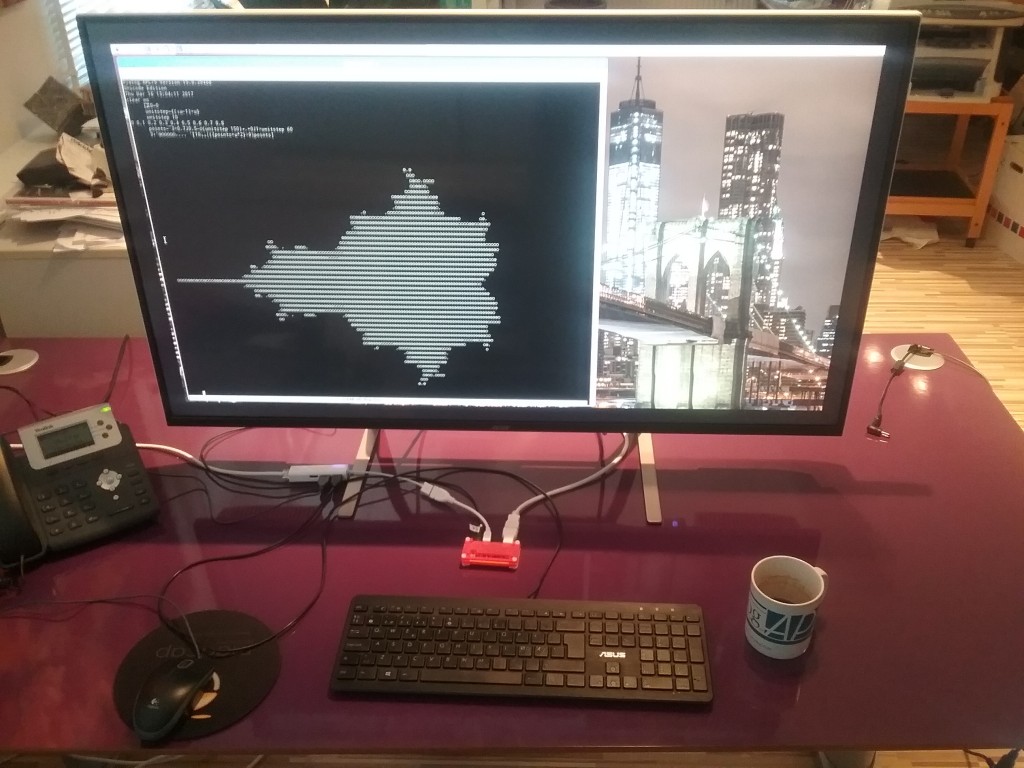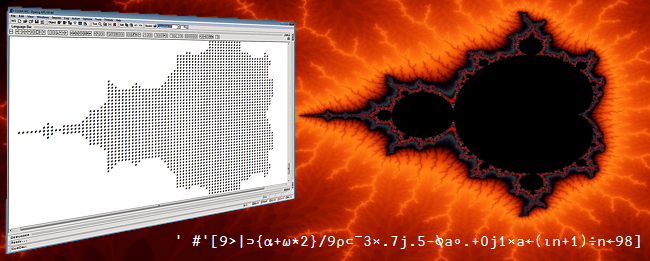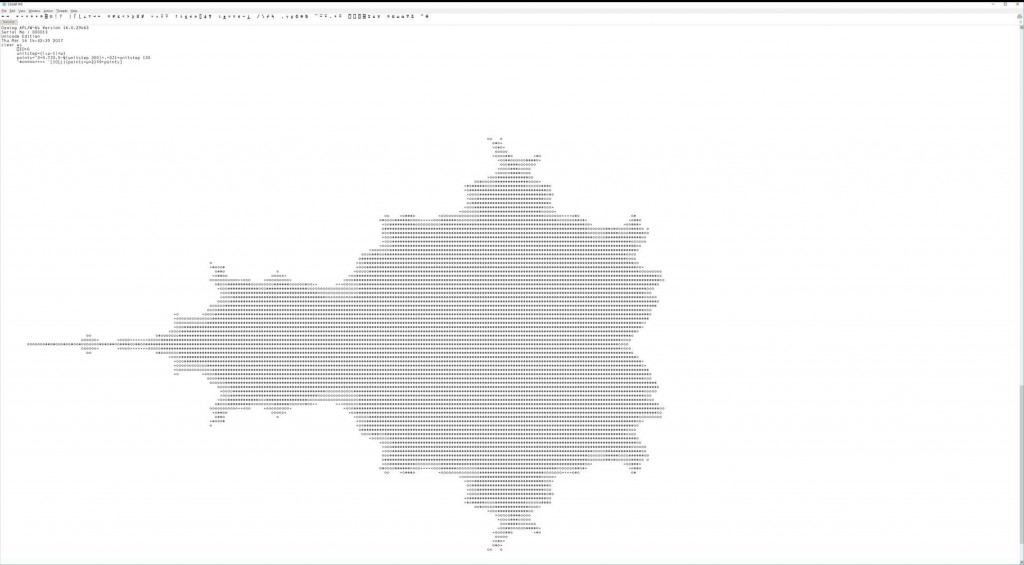Friday Afternoon
It’s something of a custom in Dyalog to send a “fun” e-mail to the group on Friday afternoons. My gambit for this past Friday was:
x ←' according to research it doesn''t matter'
x,←' what order the letters in a word are'
x,←' the human mind can still read it'
x,←' the only important thing is that'
x,←' the first and the last letters are in the right place'
∊ ' ',¨ {(1↑⍵),({⍵[?⍨≢⍵]}1↓¯1↓⍵),(-1<≢⍵)↑⍵}¨ (' '∘≠ ⊆ ⊢) x
aroidnccg to reasrech it dneso't mttear waht order the ltreets
in a wrod are the hmaun mnid can sltil read it the olny
imartpnot tihng is that the fsrit and the lsat lterets
are in the rhigt palce(The research: http://www.mrc-cbu.cam.ac.uk/people/matt.davis/Cmabrigde/rawlinson/)
Code Golfing
The code golfers were not long in responding:
∊{' ',⍵[1,(1+?⍨0⌈¯2+n),n/⍨1<n←≢⍵]}¨(' '∘≠⊆⊢)x ⍝ fa
∊{' ',⍵[∪1,{⍵,⍨?⍨⍵-1}≢⍵]}¨(' '∘≠⊆⊢)x ⍝ fb
'\S+'⎕r{{⍵[∪1,{⍵,⍨?⍨⍵-1}≢⍵]}⍵.Match}x ⍝ fc
∊{' ',⍵[n↑1,(1+?⍨0⌈¯2+n),n←≢⍵]}¨(' '∘≠⊆⊢)x ⍝ fd
In defense of the original expression, it can be said that it follows the pattern:
- cut into words
(' '∘≠ ⊆ ⊢) xalso' '(≠⊆⊢)x - permute each word
{(1↑⍵),({⍵[?⍨≢⍵]}1↓¯1↓⍵),(-1<≢⍵)↑⍵}¨ - undo the cut
∊ ' ',¨
That is, the pattern is “permute under cut”. Moving the ' ', into the permuting function, while shortening the overall expression, obscures this pattern.
Golfing for Speed
One of the code golfers was undaunted by the highfalutin’ functional programming argument. Changing tack, he claimed to be golfing for speed (while himself travelling at 900 kph):
fe←{
p←1+0,⍸⍵=' ' ⍝ start of each word
n←0⌈¯3+¯2-/p,2+≢⍵ ⍝ sizes of windows to be shuffled
⍵[∊p+?⍨¨n]@((⍳¯1+≢⍵)~p∘.-0 1 2)⊢⍵
}
cmpx 'fe x' 'fb x' 'fc x' 'fd x'
fe x → 4.27E¯5 | 0% ⎕⎕⎕⎕
* fb x → 1.05E¯4 | +145% ⎕⎕⎕⎕⎕⎕⎕⎕⎕
* fc x → 3.39E¯4 | +692% ⎕⎕⎕⎕⎕⎕⎕⎕⎕⎕⎕⎕⎕⎕⎕⎕⎕⎕⎕⎕⎕⎕⎕⎕⎕⎕⎕⎕⎕⎕
* fd x → 1.11E¯4 | +159% ⎕⎕⎕⎕⎕⎕⎕⎕⎕⎕
The question was then posed whether the algorithm can be “flattened” further; that is, whether the expression ∊p+?⍨¨n in function fe can be done without each. The answer is of course yes (else I wouldn’t be writing this blog post :-). Flattening, or avoiding the creation of nested arrays, has the potential to reduce memory consumption and increase efficiency, because there is more potential for the interpreter to perform optimized sequential or even parallel operations.
Partitioned Random Permutations
In the old days, before general arrays, before the each and rank operators, ingenious techniques were devised for working with “partitioned” arrays: A boolean vector with a leading 1 specifies a partition on a corresponding array with the same length, basically what we can now do with ⊂ or similar facility. A detailed description can be found in Bob Smith’s APL79 paper A Programming Technique for Non-Rectangular Data.
p←1 0 0 1 1 0 0 0 0 0
v←3 1 4 1 5 9 2 6 53 58
p⊂v
┌─────┬─┬─────────────┐
│3 1 4│1│5 9 2 6 53 58│
└─────┴─┴─────────────┘
+/¨ p⊂v
8 1 133
t-¯1↓0,t←(1⌽p)/+\v
8 1 133
∊ +\¨ p⊂v
3 4 8 1 5 14 16 22 75 133
s-(t-¯1↓0,t←(1⌽p)/⍳⍴p)/¯1↓0,(1⌽p)/s←+\v
3 4 8 1 5 14 16 22 75 133
The last two sets of expressions illustrate how “partitioned plus reduce” and “partitioned plus scan” can be computed, without use of general arrays and without each.
At issue is how to do “partitioned random permute”. Answer: ⍋(n?n)+n×+\p ⊣ n←≢p.
p 1 0 0 1 1 0 0 0 0 0
n?n 5 4 10 6 2 9 8 1 3 7
n×+\p 10 10 10 20 30 30 30 30 30 30
(n?n)+n×+\p 15 14 20 26 32 39 38 31 33 37
⍋(n?n)+n×+\p 2 1 3 4 8 5 9 10 7 6Therefore:
ff←{
b←~(⊢ ∨ 1∘⌽ ∨ ¯1∘⌽)' '=⍵ ⍝ internal letters
n←≢p←b/b>¯1⌽b ⍝ partition vector for groups of same
(b/⍵)[⍋(n?n)+n×+\p]@{b}⍵
}
cmpx 'ff x' 'fe x'
ff x → 1.46E¯5 | 0% ⎕⎕⎕⎕⎕⎕⎕⎕⎕⎕
* fe x → 4.19E¯5 | +187% ⎕⎕⎕⎕⎕⎕⎕⎕⎕⎕⎕⎕⎕⎕⎕⎕⎕⎕⎕⎕⎕⎕⎕⎕⎕⎕⎕⎕⎕⎕
x6←1e6⍴x
cmpx 'ff x6' 'fe x6'
ff x6 → 5.16E¯2 | 0% ⎕⎕⎕⎕⎕⎕⎕⎕⎕
* fe x6 → 1.77E¯1 | +243% ⎕⎕⎕⎕⎕⎕⎕⎕⎕⎕⎕⎕⎕⎕⎕⎕⎕⎕⎕⎕⎕⎕⎕⎕⎕⎕⎕⎕⎕⎕
There is a puzzle from 1980 which similarly involved randomly permuting items within groups. See A History of APL in 50 Functions, Chapter 47, Pyramigram. The puzzle solution is amusing also for that fact that it used -\.
Afterword
Plobssiy, a txet wshoe words are ilivuddinaly ptemrued is rdeaable mnaliy bseacue in odirrany txet many wrods, eelpclsaiy iptnroamt wrods, are sorht. A curops wtih long and ufnmiailar wdors wuold lkiely be hard to raed atfer scuh pittarmoeun. For eapxmle:
ff t
eyonelsmeary dpihnoeissopt siiuqpeedlasan pniormoasaac oopimoentaoa
ff t
emlresaneyoy dnpepoihissot seilesiqaadupn poimrnaaasoc oaioomtpneoa
ff t
erloymneseay dhsiepopiosnt seildspqiauean praisoaaonmc oomatneiopoa


 Follow
Follow










